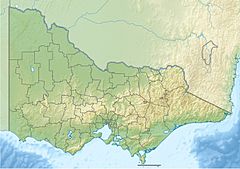Rubicon River (Victoria) facts for kids
Quick facts for kids Rubicon |
|
|---|---|
| Country | Australia |
| State | Victoria |
| Region | South Eastern Highlands bioregion (IBRA), Northern Country/North Central |
| Local government area | Murrindindi |
| Towns | Rubicon |
| Physical characteristics | |
| Main source | Victorian Alps, Great Dividing Range below Blue Range 891 m (2,923 ft) 37°27′16″S 145°51′38″E / 37.45444°S 145.86056°E |
| River mouth | confluence with the Goulburn River west of Thornton 198 m (650 ft) 37°14′35″S 145°45′0″E / 37.24306°S 145.75000°E |
| Length | 26 km (16 mi) |
| Basin features | |
| River system | Goulburn Broken catchment, Murray-Darling basin |
| Tributaries |
|
The Rubicon River is a river in Victoria, Australia. It is a perennial river, meaning it flows all year round. The river is part of the larger Murray-Darling basin, which is a huge river system in Australia.
The Rubicon River starts high up in the Victorian Alps. It then flows downhill and eventually joins the Goulburn River. This area is known for its beautiful natural landscapes.
Contents
Where is the Rubicon River Located?
The Rubicon River begins in the Great Dividing Range. This is a large mountain range in Australia. It starts below a place called the Blue Range, near the town of Buxton.
The river flows towards the northwest. It gets its water from rain and runoff from the Blue and Cerberean Ranges. Along its journey, the Rubicon River is joined by another river called the Royston River. It also connects with a smaller stream.
How Long and High is the River?
The Rubicon River is about 26-kilometre (16 mi) long. That's about 16 miles! From its start to where it meets the Goulburn River, it drops about 693 metres (2,274 ft). This means it flows from a high point to a much lower one. The river meets the Goulburn River west of the town of Thornton.
How Does the Rubicon River Help Generate Power?
The Rubicon River is home to the Rubicon Hydroelectric Scheme. This is a special system that uses the river's water to make electricity. It's a "run-of-the-river" scheme, which means it uses the natural flow of the river. It doesn't need a huge dam to store a lot of water.
The Rubicon Hydroelectric Scheme Explained
A 64-metre (210 ft) concrete arch dam helps to direct the water. This dam sends water into a long channel called the Rubicon aqueduct. This aqueduct is about 3.4-kilometre (2.1 mi) long. It carries water to the Royston Power Station. Here, it also collects water from the Royston River.
The water then travels even further, about 5.4 kilometres (3.4 mi), to the Rubicon Power Station. This power station has two special machines called Pelton wheel generators. They use the force of the water to create electricity. Each generator can make 4.6-megawatt (6,200 hp) of power.
There are also other power stations nearby. The Lower Rubicon Power Station is about 2.3 kilometres (1.4 mi) downstream and makes 2.7-megawatt (3,600 hp) of power. The Rubicon Falls Power Station makes 0.3-megawatt (400 hp) of power. This whole system was built in 1924. It is an important historical site in Victoria.
What Does the Name "Rubicon" Mean?
The river was probably first called Rubicon Creek. The name "Rubicon River" first appeared on a map in 1847. It was listed by a person named Wells in 1848.
The name "Rubicon" comes from a Latin word, rubico. This word refers to a reddish river in central Italy. That Italian river was a famous border in ancient times. When someone "crosses the Rubicon," it means they are making a decision they can't go back on.


